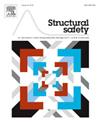Stochastic nonlinear dynamic analysis and system reliability evaluation of RC structures involving spatial variation under stochastic ground motions
IF 6.3
1区 工程技术
Q1 ENGINEERING, CIVIL
引用次数: 0
Abstract
Dynamic analysis and system reliability evaluation are crucial in the design of seismic-resilient reinforced concrete (RC) structures. Uncertainties in earthquake ground motions (EGM) and the spatial variation of heterogeneous concrete must be thoroughly considered. However, implementing these analyses poses significant challenges due to the inherent complexity and high computational costs associated with stochastic nonlinear dynamic analysis and the quantification of concrete’s spatial variation through random field theory. To address these issues, we propose a novel methodology for the stochastic dynamic analysis and system reliability evaluation of RC structures involving spatial variation under stochastic ground motions. In the methodology, a two-scale random field model developed within the framework of stochastic damage mechanics is adopted to capture the coupling effects of the nonlinearity and the spatial variation of concrete. Additionally, a physical-based stochastic ground motion model is utilized to represent the randomness of EGM. Furthermore, the probability density evolution method is employed to derive probabilistic information (statistical moments, and probability density function (PDF), etc.) of dynamic responses, and the system reliability is evaluated by the physical synthesis method. A well-designed five-story RC frame structure is analyzed to demonstrate the efficacy of the proposed methodology and to investigate the influence of concrete’s spatial variation and randomness of EGM on structural responses. The results indicate that the proposed methodology can effectively obtain the probabilistic information of stochastic responses and system reliability, and the concrete’s spatial variation has a non-negligible impact on the structural responses and system reliability.
随机地震动作用下空间变化RC结构随机非线性动力分析及系统可靠性评价
在抗震钢筋混凝土结构设计中,动力分析和系统可靠性评估是至关重要的。地震动的不确定性和非均质混凝土的空间变化必须充分考虑。然而,由于随机非线性动力分析和通过随机场理论量化混凝土空间变化的固有复杂性和高计算成本,实施这些分析带来了重大挑战。为了解决这些问题,我们提出了一种新的方法,用于随机地震动下涉及空间变化的RC结构随机动力分析和系统可靠性评估。该方法采用随机损伤力学框架下建立的双尺度随机场模型来捕捉混凝土非线性与空间变化的耦合效应。此外,利用基于物理的随机地震动模型来表示EGM的随机性。在此基础上,采用概率密度演化法推导动力响应的概率信息(统计矩、概率密度函数等),并采用物理综合方法对系统可靠性进行评估。通过对一个精心设计的五层钢筋混凝土框架结构进行分析,证明了所提出方法的有效性,并研究了混凝土的空间变化和EGM的随机性对结构响应的影响。结果表明,该方法能有效地获取随机响应和系统可靠度的概率信息,混凝土的空间变异对结构响应和系统可靠度的影响不容忽视。
本文章由计算机程序翻译,如有差异,请以英文原文为准。
求助全文
约1分钟内获得全文
求助全文
来源期刊

Structural Safety
工程技术-工程:土木
CiteScore
11.30
自引率
8.60%
发文量
67
审稿时长
53 days
期刊介绍:
Structural Safety is an international journal devoted to integrated risk assessment for a wide range of constructed facilities such as buildings, bridges, earth structures, offshore facilities, dams, lifelines and nuclear structural systems. Its purpose is to foster communication about risk and reliability among technical disciplines involved in design and construction, and to enhance the use of risk management in the constructed environment
 求助内容:
求助内容: 应助结果提醒方式:
应助结果提醒方式:


